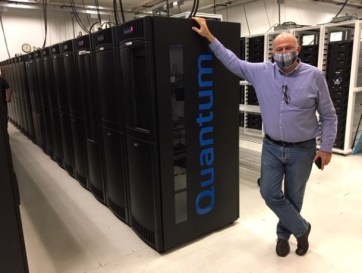A Trifecta of Veeam-Ready Solutions
ActiveScaleThey say the most interesting things in life come in sets of threes. Certainly, some sets are more interesting and simpler than others, such as live, love, laugh, or rock, paper, scissors, or my favorite, the good, the bad, and the ugly. While not super philosophical, they are easy concepts to remember and, in some cases, simplify our daily lives. When we think of things that we need to simplify in a data centric environment, we think of data management, data security, and data protection. Quantum has made a commitment to provide leading solutions that simplify; this is clearly apparent as we continue to work with Veeam offering solutions around data management, security, and protection. Quantum has been a long-standing partner of Veeam and has been certified as Veeam Ready, a program that ensures compliance with functionality and performance standards put forth by Veeam.
As the evolution of Big Data continues, the three core topics of concern to date are protect, secure, and manage data. The industry has done a decent job of providing data protection. Data Management is an emerging market segment focused on unstructured data. Recent hacking and ransomware attacks have brought concerns around data security to the forefront of people’s minds. Quantum has been a Veeam partner for a long time, since Veeam 9.5 Quantum DXi deduplication appliances and award-winning Scalar tape libraries have been certified with Veeam. Quantum’s most recent addition to the portfolio, Active Scale Object Storage , has also been Veeam Ready (v10) certified. Here is the full portfolio that is Veeam 10 Ready certified:
Veeam Integrated DXi Deduplication Appliance
DXi backup appliances offer cost-effective, fast backup and restores for mission-critical product data. Our customers love our DXi for many reasons, but feedback we often hear is that the DXi replication starts just after the first file is backed up without waiting for the end of the Veeam task, so the period of risk—the gap between when a backup is done and a copy is safely off site—is incredibly short, unlike some competitor’s solutions that start the replication only when the Veeam task is done. In v10, Fast Clone feature improves synthetic full performance by referencing existing data blocks on volumes instead of copying data blocks between files and copying those blocks only when files are modified. We have seen up to 15x improvement in our test labs and customer deployments in the speed and in some cases reduced the creation time from hours to minutes.
Veeam Ready Scalar Tape Library
Quantum Scalar tape solution for compliance, long-term retention requirement and ransomware protection. Quantum Scalar library is the only tape system in the market that uses Active Vault, a hands-off approach to managing media between an active and vaulted partition that is completely disconnected from the network. This enables our customers to fully airgap their data and thwart the effects of ransomware or other malware.
Veeam Ready Object Immutability – Active Scale Object Storage
ActiveScale is Quantum’s object storage system that provides a data-forever storage infrastructure. The ActiveScale system architecture accommodates storing primary copy of multi-petabyte-scale datasets that are highly durable and facilitates long-term data retention with minimal administrative overhead. With a Veeam Ready Object Immutability certification, Quantum solutions offer clients the ability to leverage our appliances efficiently through the Veeam GUI.
For more information on testing criteria or detailed information about how Quantum’s portfolio can help you achieve your data protection requirements, visit us our Quantum & Veeam web page or talk to one of our solution representatives.










